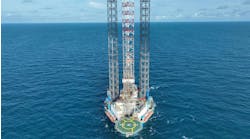Frank Hartley • Houston
Oseberg well production test
Following hydrochloric acid treatment, a new well began production from the Shetland Chalk formation at the North Sea’s Oseberg field. Further testing is necessary before commercial production from the formation is deemed viable.
“The first results are promising, but we need to test further before we can evaluate the potential,” says Morten Mikkelsen who heads petroleum technology in the Oseberg organization.
Since Oseberg began production on Dec. 1, 1988, the Shetland Chalk formation has been just one of the structures the drill bit has passed on its way down to the Brent sandstone formations.
StatoilHydro has long been aware that oil and gas also lie in the upper part of the field, but the production characteristics in the tight chalk are much more difficult than in the main reservoir. This part of Oseberg has therefore remained untested until now.
The goal is to see if commercial production is viable with well B-24 B, which is now in production. Production in the start-up phase is good, but it will take time to gauge the well’s long-term productivity, according to the operator.
Expediting offshore decisions
Today’s advances in compute power and surveillance instrumentation produce mountains of insightful data that can be extremely useful in oil-field exploration, development, and operations. On the other hand, data volumes can overwhelm traditional analysis techniques, impeding E&P professionals’ abilities to make timely decisions to bid for leases, evaluate new field-development opportunities, shorten the time to first oil, and produce oil and gas from its assets more efficiently.
Microsoft says that the solution is to expand cost-effective, easy-to-use business intelligence (BI) capabilities to a broader set of oil and gas industry end users. Until recently, BI capabilities were available only to E&P companies’ financial analysts looking for more efficient ways to maximize return on capital and cut costs. However, the need for BI tools has extended to engineers, geologists, geophysicists, geoscientists, and operations personnel. This leads to the possibility of “ubiquitous BI” – or taking deep problem-solving capabilities from the hands of a just a few into the hands of everyone who needs it to make critical E&P decisions.
Microsoft continued to say that today’s more powerful, visual and people-centric portal and BI platform, such as Microsoft Office PerformancePoint Server, represent the next wave of capabilities that bring people new opportunities for optimized production, higher profits, and safer operations. With a Microsoft Office-like look and feel, PerformancePoint Server integrates powerful analytical tools with Microsoft Office SharePoint Server and Office Enterprise products that include a set of Unified Communications tools to complement the BI tools. This solution empowers teams to collaborate and work effectively and efficiently no matter where they are, and also provide the foundation for using data in new ways, the company says.
The company explains, for example, geophysicists and geologists commonly work on interdisciplinary development teams with reservoir and production engineers, geoscientists, sedimentologists, petrophysicists, and other E&P disciplines. Together, they predict asset performance in developing new offshore fields or in extending existing ones. New and more widely available BI tools amplify teams’ abilities to easily view near-real-time information as key performance indicators (KPIs) to keep track of finding costs, development costs, and lifting costs. Slice and dice capabilities allow the asset team to compare production performance and ROI versus available capital, revenue variance and profit per barrel, energy consumption, and other business-health indicators.
According to the company, operations teams can now see information from dispersed departments as KPIs in a matter of seconds or minutes to help identify the most economic drilling investments. This information was previously captured in dozens of reports that took days or weeks to access and analyze. Rounding out the capabilities of PerformancePoint are integrated planning, budgeting, and forecasting tools to analyze the impact of variances and manage changes in the overall execution plan to meet a company’s E&P objectives.
It’s ultimately about putting BI in the hands of those people who need it most – everyone. People can easily visualize and evaluate E&P metrics and make faster and better decisions with right-time, role-based, and context-relevant data that will help upstream companies increase production, improve safety, and remain competitive, says Microsoft.
New casing running tool
BJ Tubular Services has developed a new casing running tool – 500 (CRT 500) – a top drive design that improves the safety and efficiency of casing running operations, according to BJ.
The company says that by using the CRT 500 system to run casing on highly deviated and long reach wells, operators can save rig time and enhance success rates typically encountered when dealing with problem formations and extended reach applications.
“We are very excited about the expansion of our casing running system portfolio to include the CRT 500,” says Brad Pellegrin, area manager-Americas for BJ Tubular Services. “We can offer special assistance requiring a custom casing running solution, particularly in highly deviated extended-reach wells. We are very pleased with the outcomes we’ve achieved, especially in terms of reduced rig time and associated cost-savings.”
A key advantage of the CRT 500, BJ explains, is its ability to rotate and reciprocate the casing string while simultaneously filling and circulating mud through the tool within the safety parameters of its 500-ton (454-metric ton) weight capability, which is essential for handling heavier string weights that are now commonplace in the industry. The remotely operated system also makes it possible to run casing by drawing upon power supplied by the rig’s top drive.
BJ says it has completed a custom casing running operation on an extended reach highly deviated well for a major operator in the Gulf of Mexico using the CRT 500. As a result of applying this customized approach, the operator realized a savings of nearly $1 million, the company says.




